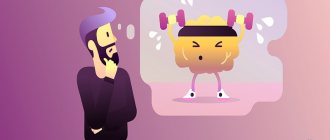Human characters are very diverse, but among them, nevertheless, typical “drawings” can be distinguished. To describe some of these patterns in psychology, there is the concept of “accentuation.” This is the name given to the sum of the most clearly defined character traits that are within the clinical norm, but make a person vulnerable to psychological stress of a certain type. Astheno-neurotic accentuation is one of its variants. T&P talk about the difficulties an asthenic person faces and what to do if you have such a character.
Accentuation is not a mental illness.
Its presence only means that a person has more clearly defined character traits, although any specialist will say that he is healthy. The creator of the concept of accentuation, German psychiatrist Karl Leonhard, for example, wrote that “the population of Berlin is 50% accentuated individuals and 50% standard type of people.” However, under unfavorable circumstances, accentuation can still turn into pathology. “Character accentuations differ from psychopathy in the absence of simultaneous manifestation of the triad of characteristics characteristic of the latter: stability of character over time, the totality of its manifestations in all situations, social maladjustment,” write the compilers of the Encyclopedic Dictionary of Psychology and Pedagogy (2013). In other words, the characteristic features of an accentuated character do not appear all the time, and living among people does not become more difficult because of them.
In Russian psychology, accentuation remains a popular concept, but there is no generally accepted classification today. Modern versions of the typology are based on the work of Karl Leonhard, the monograph of the Soviet psychiatrist Andrei Lichko and other studies. Lichko's work allowed for a deeper understanding of the etiology of neuroses, since the psychiatrist put forward the concept of the so-called “places of least resistance” in character. Knowing their “location” allows a person to avoid emotional overload, troubles in communication and wrong steps in life.
Unsure sprinter
A person with the character of an astheno-neurotic type - an asthenic - quickly starts up and quickly dries out. It’s like an airplane with too small a fuel tank: you can’t fly far, the route and speed must be carefully calculated, and you have to stop to refuel along the way. An asthenic person has increased excitability, neuropsychic sensitivity, and fatigue. Where a person with a different personality pattern is just starting to swing, he already reacts with all his might, and where it’s time to properly accelerate, he freezes and retreats into the background. At the same time, an asthenic person may feel “mentally tired” and feel strong nervous tension under the influence of fairly harmless stimuli. His only desire in this case may be the desire to quickly force everyone to get behind him.
At the same time, a person with astheno-neurotic accentuation is suspicious, impatient, irritable and at the same time prone to repentance. His grievances against the world around him can accumulate for a long time, silently layering on top of each other, only to then begin to break through the thick layer of self-doubt in the form of causeless (as it seems) outbursts of anger. After each such outburst, the asthenic person will regret and blame himself, which is why his self-esteem, already low, may lose a few more points.
Self-doubt is another characteristic of this type. An asthenic person is sensitive to criticism and evaluation; it is easy for his pride to be dealt a blow. At the same time, such a person may not be alien to vanity, which, due to the tendency to be a sprinter in everything, can be difficult to satisfy.
Research by a German professor
Before Kretschmer could identify the relationship between temperament and body structure, and also identify three main types of temperament, he had to study many people. And it is worth noting that his works on studying the relationship between physique and personality make up the majority of all the scientist’s publications (and he has more than 150 of them).
Around 1918-1920, Kretschmer had several brilliant ideas that made the professor world famous. One of the most notable results of the scientist’s active work and research was his main work, published in 1921, a publication entitled “Korperbau und Charakter,” which translated means “Body Structure and Character.” Thanks to her, the whole world learned about the German psychiatrist.
In this publication, the professor described in detail the types of human physique and how physique and temperament are interrelated. After examining more than two hundred patients, Kretschmer was able to identify four main body types, three of which were clearly defined (leptosomal, picnic and athletic), and the fourth was less pronounced (dysplastic).
We recommend: Peter Gannushkin: biography and contribution to science
The basis for this division of somatotypes was the results of studies of absolutely healthy people, as well as the diagram of the relationship of tissue structures in the body, originating from the three germ layers. Taking into account the degree of expression of a particular type of tissue (endoderm, ectoderm or mesoderm) and using a 7-point scale, Kretschmer derived formulas to describe “pure” character types:
- 7-1-1 – picnic type.
- 1-7-1 – asthenic type.
- 1-1-7 – athletic.
Neurosthenic and psychasthenic: frightening doubts
People of an asthenic-neurotic type are also sometimes divided into neurasthenics (this word is known to many, but is rarely used correctly) and psychasthenics. If an asthenic person is simply tired, sad and lost, then a neurasthenic person also suffers from psychosomatic problems: pain of unknown origin, insomnia, increased heart rate. Hypochondria - an obsessive groundless fear for one's health and painful suspicions that something is already wrong with him - is his frequent companion. By constantly listening to himself, a neurasthenic only undermines his physical well-being. He is that rare case when you can really say: “All diseases come from nerves.” On the other hand, the presence of such a quality means that it is enough to cope with emotional problems and put your relationships with the outside world in order - and there will be no need for medication.
© Javier Jaen
A psychasthenic person, unlike his “colleague” in accentuation, does not suffer from hypochondria. In his case, the sad pedestal of everyday problems is occupied by doubt: in oneself and in circumstances. A person of a psychasthenic type can doubt for a long time and without any objective grounds. His anxious suspiciousness, persistent penchant for reflection and constant surgical introspection slow down many productive intentions and exhaust the psychasthenic before he can reach the finish line. It can be difficult for such people to cope with the burden of responsibility and the high demands of others. At the same time, they are reasonable, reliable, prone to order and accuracy, and behave smoothly, without outbursts or outbursts. If a psychasthenic nevertheless manages to overcome doubts, he becomes as impatient as a person with an ordinary asthenic disposition. This also happens due to lack of self-confidence: it is better to act quickly, otherwise “something might not work out.”
Physical Features
Asthenics are, first of all, thin individuals. Their constitution is characterized by underdeveloped muscles. Such people have fragile health and do not tolerate low temperatures well. Even in the summer, the legs and arms of asthenics remain cool. Both in childhood and in adulthood they are susceptible to various pathologies.
Recovery from illnesses is slow. Often such individuals suffer from sleep disorders. Asthenics are people with fast metabolism. Even eating desserts does not contribute to weight gain in such individuals. They are distinguished by characteristic external features: an elongated head shape, long limbs, narrow shoulders and hips. The skin of these people is usually pale and prone to dryness. They have a quiet voice, but despite this, they can be talkative.
As for taste preferences, asthenics prefer desserts, pickles, sour dishes, and hot drinks. Many of them love alcohol, which is a prerequisite for the development of alcohol dependence.
If you are asthenic: practice of strengthening self-esteem
The main problem of the astheno-neurotic type is that it is not possible to maintain a high pace of life. Where do you get self-confidence? Where to find strength? Oddly enough, lifestyle partially helps to answer these questions: regular physical activity, contrast showers, self-massage. Strengthening muscles allows you to feel self-confidence “literally”: on a physical and psychological level, and massage helps you relax.
In addition, it is useful for asthenics to regularly share leisure time with other people, in company, and try to feel comfortable in society by developing new social habits. However, the most important thing, perhaps, is to praise yourself more often. If there is irritation that you have successfully managed not to splash out on your neighbor, Fr. If you did a good job, take everything apart and praise you for every detail. In addition, you can list your merits in a list or even write yourself a letter, which will talk about why you, an asthenic person, are good and beautiful.
How to find out your type
There is a very simple and convenient way to find out what type a woman is. We measure the circumference of the wrist using a measuring tape. If the result is less than 15 cm, your type is asthenic, from 15 to 17 cm - normosthenic, and if the wrist girth exceeds 17 cm - hypersthenic. The Solovyov index is the name of this parameter.
We do not always have such a measuring tool with us. Often, just by looking at a woman’s hands, we can easily determine what type she belongs to. We can recognize women of asthenic physique by their characteristic thin, elongated arms and legs, narrow shoulders, and graceful long neck. Their faces also have an elongated shape. These are, most often, ladies above average height.
An asthenic woman is characterized by energy and lightness. The structural features of the body also affect the state of health. Asthenic is usually low hemoglobin, blood pressure is below normal. And often, due to the fragility of the skeletal system, women have problems with the spine. Asthenics often suffer from vegetative-vascular dystonia, frequent colds and stomach problems. They love warmth and really dislike cold. An asthenic woman can compensate for and develop missing skills, such as strength and endurance, by doing dancing, aerobics, and swimming.
Characteristics of people with asthenic physique
Positive character traits:
- accuracy and conscientiousness;
- absence of violent emotional manifestations;
- scrupulousness in performing any processes;
- decency towards others;
- caring for family and friends;
- conscientiousness in the performance of one's duties.
Negative points in character:
- shyness and bashfulness;
- gloominess;
- lack of communication;
- irritability, often for a far-fetched reason;
- unwillingness to take responsibility;
- uncertainty and reluctance to defend one’s opinion.
In every person, some traits appear more, others less. However, the asthenic type can be combined with other options.
How to determine which type you are?
The easiest way
– measure the circumference of a woman’s wrist below the protruding bone.
- Up to 16 cm – asthenic build;
- 16-18 cm – normosthenic;
- More than 18 cm – hypersthenic.
You can do without a centimeter.
The thumb and middle finger of one hand clasp the wrist of the other hand below the bone.
- Fingers cover one another - ectomorph.
- Fingers touching each other - mesomorph.
- Fingers not touching – endomorph.
This is possible through regular observations of your own body: for example, how quickly weight is gained and lost.
In fitness centers you can undergo special testing, which includes measuring certain physical data. This method is considered one of the most reliable.
Also, any trainer will be able to determine a person’s body type in two simple ways:
- in the first - by measuring the width of the elbow joint bent at a right angle and comparing it with the indicators;
- in the second - along the intercostal angle: the thumb and index finger are applied to the lower ribs in the lateral area, the resulting angle between the fingers indicates what kind of physique the person has: less than 90 o - hyposthenic;
- 90 o – normosthenic;
- more than 90 o – hypersthenic.
When hearing the expression “asthenic physique,” not everyone understands what we are talking about. What signs does a person who is characterized in this way possess? Asthenic, translated from Greek, means weak. People of this type are underdeveloped, sickly, and have poor health. They find it difficult to tolerate cold weather. Even in summer, asthenics have cool feet and hands.
Let us consider in more detail the distinctive features of the asthenic physique and body type of this type.









